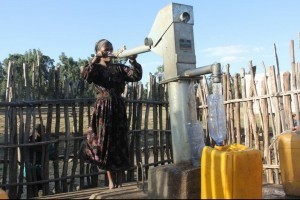
Sept. 2014—You are thirsty. Now imagine walking six hours round trip, only to reach dirty water at your destination.
That’s what Semegn Mikir did every day just to acquire water for her family in Ethiopia. Mikir is the mother of a 2-year-old daughter and lives in the rural Lay Gayint district in Taria Georgies village.
She wasn’t alone in her hardship. According to UNICEF, only 31 percent of Ethiopian households have access to safe water. Many water sources cause outbreaks of illness in both rural and urban areas. Human and livestock waste contribute significantly to water contamination.
USAID food assistance partner Food for the Hungry works in nine districts in the Amhara region to increase access to clean water. The five-year project, funded by USAID’s Office of Food for Peace, began in 2011 and is improving the health and nutrition of Ethiopians, with a focus on women and children under 5 years old.
In the Amhara region where Taria Georgies is located, Food for the Hungry worked with the local government to identify potential sites for the construction of potable water supply sources such as springs, hand-dug wells and roof water harvesting structures. Mikir, 20, can now access a new well built near her home earlier this year.
“Before this well was dug in our village … the water source was very dirty and full of mud,” she says. “During dry seasons, the spring would be low and sometimes I’d come back with empty containers. Now I walk only half an hour to reach the water well. The water is clean and safe to drink.”
To ensure the sustainability of this and other wells and the project’s new water supply sources throughout the region, Food for the Hungry organized village committees to oversee the water projects. These committees help their communities respond to water needs by planning and constructing small-scale irrigation systems, digging latrines, or building more wells. The committees also protect natural resources so the village can benefit from clean water supplies for years to come.
The project is working to build an additional 16 water sources across Amhara this year. Last year, the project supported the construction of 55 new water access points, reaching more than 15,000 people, and has helped establish community committees like the one in Mikir’s village to manage these new sources.
In addition to strengthening food security through better access to clean water, the project provides both cash and food resources as part of the Government of Ethiopia’s Safety Net Program, building a more resilient community in Lay Gayint and beyond.
LINKS
Follow @USAIDEthiopia, on Flickr, on YouTube







Comment
Make a general inquiry or suggest an improvement.